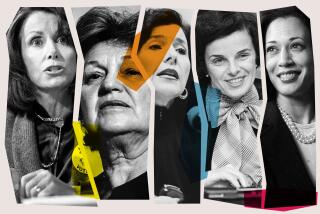The Women of the Year That Was
Long ago, before soccer moms ran riot and angry white men seethed their way to celebrity, there was the vaunted Year of the Woman.
It was 1992. Anita Hill was a feminist heroine and Bill Clinton was knocking on the White House door. In a hail of hype, a record 48 women won seats in the House of Representatives, nearly doubling their ranks in the 435-seat chamber.
In the U.S. Senate, women tripled their number by capturing four seats, giving them an all-time high of six in the 100-member Old Boys Club. Topping the marquee were California Democrats Barbara Boxer and Dianne Feinstein, the first all-female Senate tag-team elected in the whole history of the Republic.
Trends come and go, in politics no less than in fashion. Soon after Boxer, Feinstein et al. took office, a leading women’s political group launched a campaign hoping to build on its success.
“They called 1992 the ‘Year of the Woman,’ ” one advertisement said. “Do we get only one?”
Well, yes.
Soon the legion of ladies was replaced by the image of men on the march. Their colicky contempt for Congress sparked the 1994 Republican Revolution and made the angry white male the all-purpose symbol of an aggrieved and alienated electorate.
Until 1996. Then, vast armies of soccer moms rose up to seize the media spotlight, symbolizing the emergence of suburban sensibilities as the animating force in American politics. This too shall pass, as surely as ’98 follows ’97. The minivan armadas will return to their two-car garages and the soccer mom will inevitably be supplanted in the popular punditry by an election-year icon to be named later.
But in the meantime, that Senate class of ’92 is up for renewal. And the varied prospects of its members suggest that it’s one thing to ride a political wave and quite another to stay afloat after the surge has passed.
(Of the 48 women in the House class of ‘92, 18 have since washed out. Overall, 53 women now serve in the House and nine in the Senate--both records.)
Among the four Senate alumnae of the Year of the Woman, Feinstein is by far the best off politically. She won her seat in 1992 in a special election to finish the final two years of Gov. Pete Wilson’s term and was reelected, albeit barely, in 1994. Having survived the mother of all negative campaigns that year, she now has the charmed choice of running in 1998 as the favorite for California governor or staying put and angling for the No. 2 spot on the Democratic ticket in 2000.
Boxer is not nearly as well-situated. She has been a top target of Republicans ever since she limped into office with an unimpressive 48% of the vote. Recent polls suggest another close race next year. However, through luck and hard work Boxer’s reelection prospects are far brighter than all but a few would have imagined even six months ago.
That’s hardly the case for Carol Moseley-Braun of Illinois and Patty Murray of Washington, the slackers of the ’92 Senate sisterhood.
Unlike Boxer, who has drawn a field of mostly second-string rivals, both face the prospect of top-tier Republican opposition. Moseley-Braun may even draw a challenge in her own party primary.
What accounts for the vastly differing fortunes within the Senate sorority? Quite simply, Boxer and Feinstein were better, more practiced politicians to start. And whether it was competition that spurred them or the fact that being a senator is no big deal to most Californians, neither was the least complacent once she took office.
“For Murray and Moseley-Braun, given the positions they came from, it was a much greater leap,” observed one Senate staffer. “With Boxer and Feinstein, there was none of that ‘just-happy-to-be-here’ phenomenon. Both of them came to rack up real accomplishments and not just make some symbolic statement.”
Moseley-Braun was the Cook County, Ill., recorder of deeds before her flukish win in the Democratic Senate primary. (She sneaked through after a free-spending millionaire hammered the incumbent senator, offing himself in the process.)
After surviving a rocky general-election campaign, Moseley-Braun demonstrated her seriousness of purpose almost immediately after winning election by skipping off on a monthlong vacation with her campaign manager/boyfriend. Her time in Washington has been scarcely more accomplished.
Murray, for her part, campaigned as a “mom in tennis shoes” and seemed poetically suited--post-Anita Hill--to replace a Democratic incumbent, Brock Adams, who dropped out after being identified in press accounts as a serial sexual harasser. Once in office, however, the former state lawmaker mostly distinguished herself by scaring off her entire staff and acquiring a reputation as one of the Senate’s most incorrigibly bad bosses. “Mom in tennis shoes” now seems more like Mommy Dearest.
Feinstein had her own problems with staff early on. But the staff turmoil was more than overshadowed by substantive accomplishments on issues such as desert protection and a national ban on assault-type weapons.
At the same time, Boxer curbed her voracious appetite for publicity and lay low to help boost Feinstein’s 1994 reelection prospects. Feinstein, safely back in office, responded in kind by surrendering her coveted seat on the important (read $$$) Appropriations Committee to make way for Boxer and help her reelection chances.
But cooperation like that tends to obscure what remains a highly competitive relationship between the two senators and, most especially, their staff members. In that way, being elected in tandem has only served to strengthen both senators politically.
The inevitable contrast has “made them work a helluva lot harder,” said one Senate onlooker, “and therefore they’ve gotten more done.”
In contrast, Moseley-Braun and Murray present almost the perfect case study in opportunity squandered. “They all happen to be women,” Stuart Rothenberg, a Washington campaign handicapper, said in assessing the famous female Class of ’92. “But the comparison begins and ends there.”








